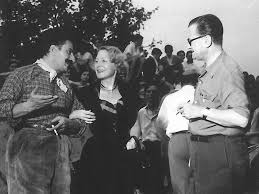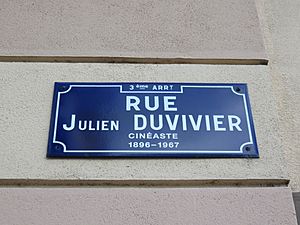Julien Duvivier facts for kids
Quick facts for kids
Julien Duvivier
|
|
|---|---|

Julien Duvivier, at right, with Italian writer Giovannino Guareschi, 1952
|
|
| Born | 8 October 1896 Lille, France
|
| Died | 29 October 1967 (aged 71) Paris, France
|
| Nationality | French |
| Occupation |
|
| Years active | 1919–1967 |
Julien Duvivier (born October 8, 1896 – died October 29, 1967) was a famous French film director and screenwriter. He was very important in French movies from the 1930s to the 1960s. Some of his most well-known films include La Bandera, Pépé le Moko, Little World of Don Camillo, and Panic.
The famous director Jean Renoir once called him a "great technician" and a "poet."
Contents
Early Years in Film
Julien Duvivier started his career as an actor in 1916. He worked at the Théâtre de l'Odéon in Paris. In 1918, he began working at Gaumont, a big film studio. There, he was a writer and helped other directors.
He directed his first movie in 1919. In the 1920s, some of his films had religious themes. These included Credo ou la tragédie de Lourdes and La Vie miraculeuse de Thérèse Martin, which was about a saint named Thérèse of Lisieux.
Making Movies in the 1930s
In the 1930s, Duvivier joined a film company called 'Film d'Art'. He worked with them for nine years. His first big success was David Golder (1930). This was also his first "talkie," meaning it was a movie with sound. He worked many times with the actor Harry Baur during this period.
In 1934, Duvivier started working with another famous actor, Jean Gabin, on the film Maria Chapdelaine. For La Bandera (1935), he teamed up with the talented writer Charles Spaak. They would also work together many times.
After making Le Golem (1936), a remake of an old German horror film, Duvivier directed La belle équipe (also 1936). This film starred Jean Gabin and is still an important example of his work. It's about five unemployed friends who win the lottery. They decide to buy a café and dance hall by the sea. But unexpected things keep happening, especially when jealousy over a woman gets in the way. The movie originally had a sad ending, but a happier one was also filmed and released. Both versions still exist today.
While L'Homme du jour (1936) is a smaller film, Pépé le Moko and Un Carnet de Bal (both 1937) are considered masterpieces. Pépé le Moko was set in the gangster world of Algiers and made Jean Gabin an international star.
In 1938, Duvivier went to Hollywood and made his first American film, The Great Waltz. It was a movie about the composer Johann Strauss II. He returned to France the next year to make La Fin du jour, about retired theater actors trying to save their retirement home. This was followed by La Charrette fantôme, a horror film. In 1940, his film Untel père et fils couldn't be shown in France until after World War II due to the political situation.
Working in America During World War II
During World War II, Julien Duvivier moved to the United States to continue making movies. He stayed in Portugal for a few days before crossing the Atlantic.
In the U.S., he directed several films. These included Lydia (1941) and two films made of several short stories: Tales of Manhattan (1942) with stars like Charles Boyer and Rita Hayworth, and Flesh and Fantasy (1943) with Edward G. Robinson and Barbara Stanwyck. He also made The Impostor (1944), which again starred Jean Gabin.
After the War: Back in France
When Duvivier came back to France, it was a bit hard for him to get his career going again. His film Panic (1946) was a very dark and intense movie. It didn't do well with critics or the public.
However, Duvivier kept working in France for the rest of his life. He did go to Great Britain for a short time to film Anna Karenina (1948) and to Spain for Black Jack (1950).
Under the Sky of Paris (1951) was a very creative film. It followed different people in Paris over the course of a single day, showing how their lives crossed paths. In the same year, Duvivier directed the first of the popular and funny Don Camillo films, Le Petit monde de Don Camillo. This movie was a huge hit, and he followed it with The Return of Don Camillo (1953). Other directors continued the series later.
In Deadlier Than the Male (1956), Jean Gabin played a kind restaurant owner who is tricked by a clever young woman. Duvivier also co-wrote and directed two films in 1957: the drama Lovers of Paris and the comedy-thriller The Man in the Raincoat.
Marie-Octobre (1959) was a suspenseful film about 11 people trying to solve a mystery. It was known for its careful direction and tense atmosphere. That same year, he was asked to be a judge at the Cannes Film Festival.
Duvivier's last film made of several short stories was Le Diable et les dix Commandements (1962). His film Chair de poule (1963) was a crime story about an untrustworthy woman.
In the fall of 1967, as he was finishing his film Diaboliquement vôtre, Julien Duvivier was in a car accident. This caused a heart attack, and he passed away at the age of 71. He directed almost 70 films in his career. He is buried in the cemetery of Rueil-Malmaison in France.
Filmography
See also
 In Spanish: Julien Duvivier para niños
In Spanish: Julien Duvivier para niños


